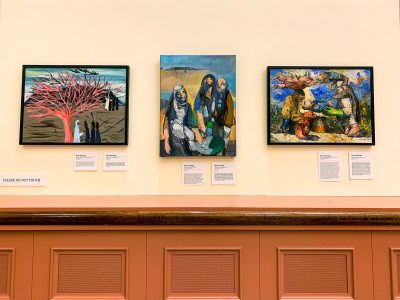
A Boston church is partnering with an international non-profit to foster religious unity through art.
The Cathedral Church of St. Paul will host an art exhibition on the life of Abraham — whom three major world religions consider their founding father — featuring paintings from three artists: one Jewish, one Christian and one Muslim. It opened in Boston Sunday as part of a two-year world tour.
The exhibition will last until Dec. 6 and was organized by CARAVAN, a nongovernmental organization founded 10 years ago in Egypt to promote interfaith understanding between the Middle East and the Western world through art.
The exhibit is composed of 15 different paintings organized into sets of three. Each set depicted one of five major themes from Abraham’s life: “Friend of God,” “The Compassionate,” “Sacrificial Love,” “Welcoming the Stranger” and “Living as a Pilgrim.”
President of CARAVAN Paul-Gordon Chandler, who spoke at the exhibit’s opening reception in Downtown Boston, said in an interview the exhibition is an “artistic response to the rise of anti-Semitism and increasing anti-Muslim sentiments.”
Chandler said he hopes the paintings will serve as a catalyst for friendship between worshippers of different religions.
“Out of all of this, I should say that the goal is not interfaith dialogue, though that’s very important,” Chandler said. “But behind it all, the goal is really facilitating greater understanding so that interfaith friendships are developed.”
Artists Qais Al-Sindy, Sinan Hussein and Shai Azoulay — of Christian, Muslim and Jewish faiths, respectively — created one painting for each of the five sets.
While all three paintings in each set are displayed under the same title and reflect the same subject, the artists often depicted different scenes in their individual works.
CARAVAN selected the artists for the exhibition, Chandler said, based on their reputations on the global scene, the potential harmony between their different styles and the value they place in art as a tool for peace-building.
Al-Sindy, born in Baghdad, Iraq, was an engineer before he obtained a master’s degree in art. He said the exhibition’s message reflects that of a family story he was told in which his Christian grandfather would share meals with his neighbors, one Muslim and one Jewish, by eating from the same plate.
“Imagine like when you eat with somebody at the same plate; that means you trust him 100 percent, you love him, you understand him,” Al-Sindy said. “And I think nowadays, these things are disappearing. That’s why I believe that this project, ABRAHAM, is a good step to try to tie these faiths together.”
Al-Sindy described his painting style as abstract exhibitionism and said he wants to relay a message of hope and love through his work.
“Instead of throwing bricks at each other, why don’t we collect these bricks and build a bridge between us and we can meet at the top of this bridge?” Al-Sindy said. “Since art is a language without borders, I hope this message can be conveyed and understood.”
Hussein, a Muslim-American who graduated from art school in Baghdad before fleeing the city during the Iraq War, said his painting style differs from that of others in the Middle East. He describes his works as less realistic but more figurative with some elements of surrealism.
“If you see a lot of my paintings, you see a lot of story,” Hussein said. “I make a lot of story in one painting.”
Israeli-born Azoulay attended art school in Jerusalem and still lives there today. He said he attempts to bring out the organic essence of humanity in his paintings.
“There is something with painting — it’s very here and now,” Azoulay said. “So I’m looking for this human moment. And I love colors.”
Azoulay said he is inspired by his daily life, his dreams and his family, and that his ideas stem from “being a person in this complicated world.”
Chandler said CARAVAN selected Boston as one of the exhibition’s U.S. tour stops because of the city’s sizable Jewish and Muslim populations. St. Paul’s Cathedral also hosts local Muslims every Friday for their Jummah prayers, which Chandler said sets an example for inter-religious unity.
Reactions to the artwork have varied by location, Chandler said, as each stop on the global tour carries its own cultural context. During its Rome debut, the exhibition brought together two religious communities that normally didn’t mix without outside impetus.
“The Christian community, being that the Vatican is headquartered there, does a lot with each of the different traditions,” Chandler said. “But the two coming together, Muslim and Jewish in Rome, doesn’t happen often.”
Yet, because the exhibition encountered a different societal backdrop in Paris, its focus there was more on diminishing anti-Semitic tensions, according to Chandler. The New York Times reported in February that incidents of discrimination in France against Jewish people has risen considerably in recent years.
The exhibition will continue touring until mid-2021 and Chandler said the exhibit will stop in a wide range of places including Los Angeles, Chicago and rural Wyoming.
Dorchester resident Deirdre Habershaw, 37, said she believes politics and sociological factors make it harder for different religions to coexist in peace.
“I’m really glad that that church is doing that,” Habershaw said. “I wish more people knew about it and have that mindset that there should be more unifying things than there are things that separate us.”
Sakura Regan, 18, of South Boston said she thinks followers of these three major faiths should be reminded that their religions all come from the same source.
“I think in general as religious people,” Regan said, “spirituality is a pretty unifying thing [despite] little discrepancies in the ways that it’s practiced and the different specific guidelines each religion has.”


















































































































